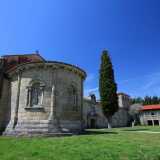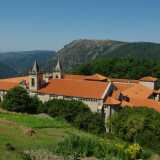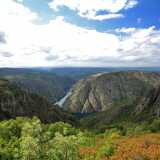Day 2 - Monasteries Route
On this route, you will visit the monasteries on the banks of the Sil River, as well as a convent that is the only place where monastic life remains active in Ribeira Sacra. This is one half of a 2-day route that lets you visit all of the existing monasteries in Ribeira Sacra.
This route begins at the Convent of San Salvador de Ferreira de Pantón, which is also referred to as the Convent of Las Bernardas. This is currently the only place in Ribeira Sacra where monastic life remains active. And when you visit, don’t try to leave without sampling the magnificent sweets they produce! ;)
After visiting the Convent of Las Bernardas, your next stop will be the Monastery of Santo Estevo de Ribas de Sil. This is the most imposing monastery in all of Ribeira Sacra, and its impressive size reflects the importance that this complex had centuries ago. It is now included in Spain’s national network of Parador hotels. You can visit three cloisters and the church, and you can also take a walk in the forest behind the monastery, where you can see the historic abattoir and ovens.
You have two options for how to arrive at the Monastery of Santo Estevo from Ferreira de Pantón:
- The shorter option: leave town towards the south on the LU-P-4103, travelling in the direction of Santo Estevo. Turn left after crossing the Sil River at A Barxa, and follow the signs to travel towards the boat dock. Continue along that highway all the way until it ends in the village of Loureiro, then turn right on OU-0508 and follow the signs to reach the monastery.
- The highway in the best condition: leave Ferreira de Pantón by taking the N-120 in the direction of Ourense. After passing the town of Os Peares, turn left in the direction of Penalba/Luintra/Monasterio de Santo Estevo. It is very easy to follow the signs from there (the ones indicating "PARADOR").
Once you have finished your visit at Santo Estevo, go back to the main highway (OU-0508) and turn right to head in the direction of Luintra. After about 500 metres you will see a sign on the right side of the road indicating "Paradela". Park your vehicle just after making that turn. From there you will need to walk about 300 metres to reach the Penedos do Castro Viewpoint. From that viewpoint you will be able to see the location of the Monastery of Santo Estevo on the slopes of Sil Canyon. In the background, you can also see the bridge at A Barxa, which is the location where the Cabe River flows into the Sil River.
Next, return to the OU-0508 highway, but this time travel in the opposite direction, in other words, towards Parada de Sil. Along the way you can stop at the Cabezoás Viewpoint. Here you will have a fantastic panoramic view over the final meander of the Sil River, just before it reaches the Santo Estevo dam.
Next, continue along the same road in the same direction until you reach the town of Parada de Sil. There you will see signs indicating the route to take to the next monastery, which is Santa Cristina de Ribas de Sil (you need to book your visit in advance at https://entradas.ribeirasacra.org/). Santa Cristina is definitely one of Ribeira Sacra’s jewels of Romanesque architecture. Its location is also impressive, completely surrounded by chestnut trees on the slopes of the Sil Canyon.
Finally, you will return to the town of Parada de Sil on your way to the final stop on this route, which is the Monastery of San Paio. Although this monastery is preserved only as ruins, it is still possible to visit and see the remains of the church, cemetery, and the historic patio-cloister. There are two options for reaching this location.
- From Parada de Sil, take OU-0604 until arriving in Vilariño Frío. There, turn left onto OU-536 and travel in the direction of Castro Caldelas/Trives. When you arrive in Castro Caldelas, turn left onto LU-903 and travel in the direction of A Teixeira. After a few kilometres you will see a turn marked as towards A Teixeira, which will take you to the monastery.
- From Parada de Sil, take OU-0605 in the direction of A Teixeira. On this road you can stop at other locations, such as the ancient chestnut tree in Entrambosrríos, the wooden walkways along the Mao River, the village of Cristosende, and the O Cachón Waterfalls (this option is only recommended at times of the year with more daylight hours).
COMMENTS
- Based on the guidelines for how much time to spend at each location, and if you begin the route at the time when the Convent of San Salvador opens for visitors, with a break for lunch in Luintra, or at the Parador hotel, or in Parada de Sil, then you should book your visit to the Monastery of Santa Cristina at 4.00 p.m.
OTHER INFORMATION OF INTEREST
 WHERE TO EAT · Click here to find the restaurants that are closest to your location at any time (the list can be filtered by municipality).
WHERE TO EAT · Click here to find the restaurants that are closest to your location at any time (the list can be filtered by municipality).
 MORE ATTRACTIONS · If you want to complement your itinerary with other attractions close to your current location, use the interactive map. Using the search feature, you can select the municipality where you are located (we recommend this option only during times of the year when there are extra daylight hours).
MORE ATTRACTIONS · If you want to complement your itinerary with other attractions close to your current location, use the interactive map. Using the search feature, you can select the municipality where you are located (we recommend this option only during times of the year when there are extra daylight hours).

The only female monastery that keeps religious life in Ribeira Sacra. Almonst known by Monastery of Bernardas

The monastery of Santo Estevo de Ribas de Sil is one of the most prominent and spectacular of the rich monumental heritage of Galicia. It was built between the 12th and 18th centuries.
There was once a castro, a hill fort, here as this was a strategic place for defending the settlement and keeping watch over the lower land. Today, from this lookout point you can see the monastery of Santo Estevo, which is also in a privileged position, high above the Sil Canyon.

Cabezoás is one of the most popular viewpoints in the Ribeira Sacra, which indicates its importance in an area characterised by the number and quality of its viewing points.
The monastery of Santa Cristina de Ribas de Sil is located in a spectacular setting in the chestnut grove of Merilán.
The monastery of San Paio de Abeleda, despite being neglected, represents an interesting collection within the Ribeira Sacra. Some authors believe it was founded in the 10th century (in the year 934, the family of San Rosendo appeared as owner of these lands). However, for others it was in the 12th century.
Don't miss!
With this route, you can add a catamaran boat trip on the river in the morning, after visiting the Convent of Las Bernardas, which you can take from the boat dock at Santo Estevo. During the summer you can also do this at the end of the day, from the boat docks at Ponte do Sil or Abeleda.
 What would you improve?
What would you improve? 